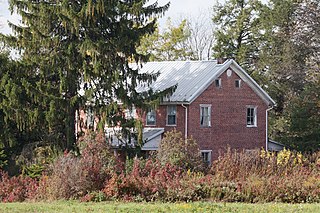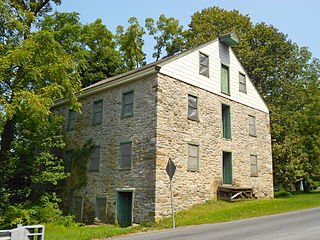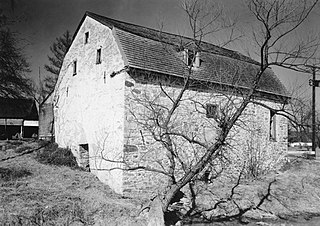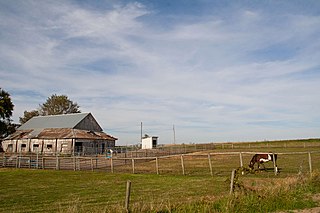
Philip Friend House is a c. 1807 historic farm house in North Bethlehem Township, Pennsylvania, US. The stone house is forty feet by thirty feet, two-story, five-bay, and gable-roofed. Contributing outbuildings include a barn, springhouse, wash house, and privy.

Stephenson–Campbell House, also known as the Stephenson–Campbell Property and the Stephenson Log House, is a historic site in Cecil, Pennsylvania containing four contributing buildings. Included are a 1778 log house, a 1929 Sears and Roebuck Company mail order bungalow style house, a 1929 spring house, and a 1928 garage. The log house is 16 feet by 34 feet, with several additions totaling about 1360 square feet. The log house is one of the few pre-1780 log houses still standing in Western Pennsylvania, and the only known example of a single story private home still extant in the area.

The John Abbott House is an historic house located on King Street in Abbottstown, Adams County, Pennsylvania, United States. It was listed on the National Register of Historic Places on February 22, 1980.

Matthew Hair Farm, also known as the Calvin Shaulis Farm and Fruit Crest, is a historic farm and national historic district located at Jenner Township in Somerset County, Pennsylvania. The district includes three contributing buildings and three contributing structures. The buildings are a Georgian-inspired vernacular brick house (1817), Germanic-influenced bank barn, and a kitchen / spring house. The house is a 2+1⁄2-story, double pile, modified central passage dwelling with a gable roof. It features a shed roof front porch. The structures are a 20th-century man-made pond, a cistern, and a windmill to pump water to the cistern.

Samuel Stoner Homestead, also known as Indian Road Farm, Bechtel Farm, and Wiest Dam, is a historic home and farm located at West Manchester Township, York County, Pennsylvania. It was built in three stages: a 1+1⁄2-story, Germanic influenced limestone banked house built between 1798 and 1801; a second story was added about 1835; and a 2-story, 3-bay stone addition, built about 1850. It measures 62 feet by 30 feet. Also on the property is a small stone and frame springhouse, a small stone smoke house, and a small frame and stone bank barn, all dating to the mid-19th century.

Henry and Elizabeth Berkheimer Farm is a historic home and farm complex located at Washington Township, York County, Pennsylvania. It includes the farmhouse (1817), Sweitzer barn (1847), summer kitchen, and wagon shed. Also on the property are a woodshed, hog barn, poultry house, and seed house, all built about 1920; a metal windmill dated to 1909; and the site of an early 19th-century woolen mill and millrace. The farmhouse is a banked 2 1/2-story Pennsylvania German vernacular dwelling built of rough cut brownstone. It measures 48 feet wide by 23 feet deep.

Springfield Mill, also known as the Piper-Streeper Mill, is a historic gristmill located along the Wissahickon Creek in Erdenheim, Springfield Township, Montgomery County, Pennsylvania. It is a building on the Bloomfield Farm tract, now part of Morris Arboretum.

Roberts-Quay House is a historic home located in the Washington Square West neighborhood of Philadelphia, Pennsylvania. The original section was built in about 1850, and expanded in 1889, 1906, 1921, and 1928.

John Brown Farm, Tannery & Museum, 17620 John Brown Rd., Guys Mills, PA 16327, is a historic archaeological site located in Richmond Township, Crawford County, Pennsylvania. The tannery was built in 1825 by famed abolitionist John Brown (1800–1859), who lived on the site from 1825 to 1835. The tannery was about 0.25 miles (0.40 km) from the new Pennsylvania and Ohio Canal.

Kutz Mill is a historic grist mill complex located on Sacony Creek in Greenwich Township, Berks County, Pennsylvania. It is adjacent to the Kutz's Mill Bridge. The complex includes the 1 1/2-story, stone mill ; brick farmhouse (1855); 1 1/2-story, stone summer kitchen; stone and frame Pennsylvania German bank barn; and three frame outbuildings. The mill is representative of a country custom mill and built as part of a working farm.

Merkel Mill Complex is a historic grist mill complex located in Richmond Township, Berks County, Pennsylvania. The complex consists of the 2+1⁄2-story, stone banked mill with tin roof (1854); 2+1⁄2-story, stone Georgian-style manor house (1767); large stone and frame barn with banked earth ramp ; one-story smokehouse with slate roof ; 1+1⁄2-story stone summer kitchen ; clapboarded frame privy ; storage shed ; and the millraces, dam, and pond. The mill ceased operation about 1939. The mill was built as part of a working farm.

Thompson Mill is a historic grist mill located on Seidel Creek in Robeson Township, Berks County, Pennsylvania. The mill was built about 1816, and is a 1 1/2-story, with basement, stone and frame building with frame extension. The adjacent farmhouse was built about 1850, and is a 2 1/2-story, five bay, stone dwelling. Also on the property is a contributing stone bakeoven and the millraces, pond, and dam. The mill ceased operation in 1950. The mill was built as part of a working farm.

Borneman Mill, also known as Stauffer Mill, is a historic "farm mill" located in Washington Township, Berks County, Pennsylvania. The mill was built to perform farm chores with water power. The mill was built before 1860, and is a two-story, with basement, post-and-beam building with vertical siding. It measures 21 feet, 6 inches, by 24 feet, 6 inches. The mill powered operations in the nearby stone bank barn by use of a cable drive system. Also on the property are a contributing farmhouse and smokehouse.

Stupp–Oxenrider Farm is a historic farm complex and national historic district located in North Heidelberg Township, Berks County, Pennsylvania. It has nine contributing buildings, one contributing site, and four contributing structures. They include a 2+1⁄2-story, log Swiss bank house ; 2-story, log, tenant / grandfather's house ; and frame Pennsylvania bank barn. The remaining buildings include a stone summer kitchen / butcher house, smokehouse, blacksmith's shop, wagon shed, milk house, and privy. The contributing structures are a chicken house, brooder house, pole shed, and roofed spring. The contributing site is a limestone quarry.

The Christian Schlegel Farm is a historic farm complex and national historic district located in Richmond Township, Berks County, Pennsylvania. It was listed on the National Register of Historic Places in 1992.

Richardson Brognard Okie Jr. (1875-1945) was an American architect. He is noted for his Colonial-Revival houses and his sensitive restorations of historic buildings.

Moses Coates Jr. Farm, also known as Meadow Brook Farm, is a historic home and farm located in Schuylkill Township, Chester County, Pennsylvania. The house is a 2+1⁄2-story, ell-shaped, stuccoed stone structure with a gable roof. The oldest section dates to about 1754, as a two-story, six-bay two room over two room house in the Georgian style. About 1800, a three-bay section was added. An addition expansion was in 1896, and the house reconstructed in 1933 for use as a clubhouse, at which time the property was converted to a 9-hole golf course. Also on the property are a contributing bank barn, carriage house, and two spring houses. During the American Revolution the house served as officer's quarters for American officers in late-1777 and early-1778 during the encampment at Valley Forge.

Squire Cheyney Farm is a historic farm and national historic district located in Thornbury Township, Chester County, Pennsylvania. The district encompasses two contributing buildings, three contributing sites, one contributing structure, and contributing object. They are the farmhouse, barn, ruins of a granary, remains of an ice house, a spring house (1799), stone retaining wall, and family cemetery. The house was built in four periods, with the oldest dated to about 1797. The oldest section is a 2 1/s-story, three bay, stuccoed stone structure with a gable roof. The additions were built about 1815, about 1830, and about 1850, making it a seven-bay-wide dwelling. It is "L"-shaped and has a slate gable roof. During the American Revolution, Thomas "Squire" Cheyney [II] informed General George Washington during the Battle of Brandywine that the British were flanking him to the north. He was later appointed to the Pennsylvania Ratifying Convention to ratify the United States Constitution. The site is now a township park known as Squire Cheyney Farm Park.

Roger Hunt Mill is a historic grist mill complex located at Downingtown, Chester County, Pennsylvania. The mill was built in 1759, and is a two-story, stone structure with a gambrel roof measuring 30 feet, 6 inches, by 48 feet. It has a one-story frame addition. The main house was built about 1740 and is a two-story, five-bay, stone structure with Georgian design details. The house has a 2+1⁄2-story, stone extension built about 1850. Other contributing buildings are the 2-story, Queen Anne-style carriage house; 2+1⁄2-story, Greek Revival style tenant house ; and 1+1⁄2-story stone miller's house.

The Josias L. and Elizabeth A. Minor Farmstead District is an agricultural historic district located northwest of Ely, Iowa, United States. It was listed on the National Register of Historic Places in 2000. At the time of its nomination it consisted of five resources, which included four contributing buildings and one non-contributing structure. The historic buildings include a 1+1⁄2-story, T-plan, half-timbered house (1856); gabled barn #1 ; gabled barn #2 ; and the summer kitchen (1850s). The corncrib is the historic structure. Family lore says that Josias Minor settled here in 1846, but an 1878 biography of him gives September 1855 as the settlement date, which is used here for dating the buildings.
























